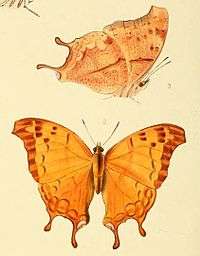Charaxes zoolina
| Club-tailed Emperor | |
|---|---|
 | |
| ♂ wet season form, and ♀ dry season form (as neanthes) | |
| Scientific classification | |
| Kingdom: | Animalia |
| Phylum: | Arthropoda |
| Class: | Insecta |
| Order: | Lepidoptera |
| Family: | Nymphalidae |
| Genus: | Charaxes |
| Species: | C. zoolina |
| Binomial name | |
| Charaxes zoolina (Westwood, [1850]) | |
| Synonyms | |
| |
The Club-tailed Emperor or Club-tailed Charaxes (Charaxes zoolina) is a butterfly of the family Nymphalidae. It is found in southern Africa.[1]
The wingspan is 40–45 mm in males and 50–58 mm in females. Flight period is from October to June.[2]
Larvae feed on Entada - Entada spicata, Entada abyssinica, Entada natalensis, Acacia natalitia, Acacia schweinfurthi, Acacia brevispica, and Acacia kraussiana.[1][2]

Subspecies
Listed alphabetically.[1]
- C. z. betsimisaraka Lucas, 1872 (Madagascar)
- C. z. ehmckei Dewitz, 1882 (Angola)
- C. z. mafugensis Jackson, 1956 (south-western Uganda, Rwanda, Burundi, Democratic Republic of Congo, north-western Tanzania)
- C. z. zoolina (Westwood, [1850]) (southern Sudan, southern Ethiopia, Somalia, Uganda, Kenya, Tanzania, Malawi, Zambia, Mozambique, Zimbabwe, northern Botswana, north-eastern Namibia, South Africa, Swaziland)
Taxonomy
Charaxes zoolina is a member of the species group Charaxes zoolina. The clade members are
- Charaxes zoolina Nominate
- Charaxes kahldeni
The group differs from all the others in Charaxes in the male having a tail on vein 2, but the female having two long tails on veins 2, 4. There are two different forms, one with black markings on a greenish white base colour (wet season form) and one with reddish-brown markings on red-yellow whitish colour (dry season form). These forms can be from eggs of the same female.
References
- Seitz, A. Die Gross-Schmetterlinge der Erde 13: Die Afrikanischen Tagfalter. Plate XIII 32 b
- Victor Gurney Logan Van Someren, 1974 Revisional notes on African Charaxes (Lepidoptera: Nymphalidae). Part IX. Bulletin of the British Museum of Natural History (Entomology) 29 (8):415-487.
External links
- Images of C. zoolina zoolina Royal Museum for Central Africa (Albertine Rift Project)
- Images of C. zoolina mafugensis (Albertine Rift Project)
- Pteron Images
- Images at Bold Charaxes zoolina
- Bold images Charaxes zoolina zoolina
- Bold images Charaxes zoolina betsimisaraka
- Charaxes mafugensis images at BOLD
- Charaxes ehmckei images at BOLD
- Charaxes betsimisaraka images at BOLD